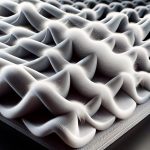When it comes to choosing performance fabrics, you’ll want to focus on how well they meet your specific needs. Durability, stain resistance, and ease of maintenance are just a few factors that play a vital role. If you’ve got kids or pets, or you’re furnishing a high-traffic area, the right material becomes even more important. Let’s explore the essential characteristics that can guide your selection and guarantee you make the best choice for your situation.
Table of Contents
Key Takeaways
- Assess durability by considering abrasion resistance and UV protection, especially for high-traffic areas exposed to sunlight.
- Choose stain-resistant fabrics like microfiber or polyester to maintain appearance in homes with children and pets.
- Evaluate breathability and stretchability for comfort in various climates and activities when selecting fabrics.
- Check maintenance requirements, opting for machine-washable or easy-to-clean fabrics for convenience.
- Explore eco-friendly options, such as recycled materials and innovative dyeing technologies, to combine sustainability with performance.
Understanding Performance Fabrics
When it comes to choosing the right materials for your space, understanding performance fabrics is essential.
These fabrics are designed to withstand wear and tear, making them ideal for high-traffic areas in your home or office. You’ll find that performance fabrics often resist stains, moisture, and fading, ensuring they maintain their appearance over time.
Performance fabrics are built to endure, perfect for busy spaces, resisting stains and fading to keep your decor looking fresh.
They’re not just practical; many also come in a variety of colors and textures, allowing you to express your style without sacrificing durability.
By selecting performance fabrics, you’re investing in longevity and ease of maintenance while enhancing your decor.
Key Characteristics of Performance Fabrics
Understanding the key characteristics of performance fabrics can help you make informed choices for your home or office. These fabrics are designed with specific attributes that enhance durability and usability. Here are some essential characteristics to take into account:
| Characteristic | Description | Importance |
|---|---|---|
| Durability | Resistant to wear and tear | Long-lasting use |
| Colorfastness | Maintains color despite exposure | Retains aesthetic appeal |
| Breathability | Allows air circulation | Comfort in various climates |
| Stretchability | Offers flexibility and movement | Enhances comfort and fit |
| UV Resistance | Protects against sun damage | Preserves fabric integrity |
Benefits of Moisture and Stain Resistance
When you choose moisture and stain-resistant fabrics, you’re investing in enhanced durability and longevity for your pieces.
These materials not only make maintenance a breeze but also support your active lifestyle.
You’ll find that they stand up to everyday challenges while keeping your spaces looking fresh.
Enhanced Durability and Longevity
While you might appreciate the look of a fabric, its performance under everyday conditions is essential for ensuring long-lasting use.
Fabrics with enhanced durability and longevity can withstand the rigors of daily life, making them ideal for high-traffic areas. When you choose moisture and stain-resistant materials, you’re investing in fabrics that repel spills and resist damage from humidity.
This means fewer stains and less wear and tear over time, allowing your upholstery or clothing to maintain its fresh appearance. Additionally, these fabrics are less likely to fade or fray, ensuring they look good longer.
With the right choice, you can enjoy peace of mind knowing your investment will endure, providing both style and resilience in your home or wardrobe.
Easy Maintenance Solutions
Choosing fabrics that offer enhanced durability not only guarantees longevity but also simplifies your cleaning routine. When you opt for moisture and stain-resistant materials, you’re making your life easier.
These fabrics repel spills and dirt, allowing you to clean them quickly with just a wipe or a damp cloth. There’s no need for elaborate cleaning methods or special detergents, saving you time and effort.
Additionally, moisture-resistant fabrics help prevent mold and mildew buildup, keeping your environment fresh and healthy. You’ll enjoy peace of mind knowing your upholstery or clothing can withstand everyday messes, whether from kids, pets, or accidental spills.
Investing in easy-care fabrics means you can focus more on enjoying your space and less on constant upkeep.
Ideal for Active Lifestyles
Whether you’re juggling a busy family life or pursuing outdoor adventures, fabrics that resist moisture and stains fit seamlessly into your active lifestyle.
These performance fabrics keep you dry and comfortable, allowing you to focus on what matters most. When you’re out hiking or running errands, moisture-wicking properties help manage sweat, preventing that sticky feeling that can slow you down.
Stain-resistant finishes mean you can enjoy your favorite foods or tackle unexpected spills without worrying about lasting marks. Plus, these fabrics are often easy to clean, saving you time and effort.
Evaluating Fabric Durability for Various Uses
When you’re evaluating fabric durability for different uses, it’s essential to reflect on how each material will hold up under specific conditions.
Evaluating fabric durability requires careful consideration of each material’s performance under various conditions.
Consider factors like abrasion resistance, which impacts how well the fabric withstands wear and tear. For instance, if you’ll be using the fabric for high-traffic areas, opt for materials like nylon or polyester, known for their strength.
Additionally, think about UV resistance if the fabric will be exposed to sunlight; some materials fade faster than others. Water resistance is another key factor for items that might encounter moisture.
Finally, always check care instructions—durable fabrics often require specific cleaning methods to maintain their integrity. By focusing on these elements, you can guarantee your chosen fabric meets your durability needs.
Selecting the Right Material for Outdoor Furniture
As you select the right material for outdoor furniture, consider how different fabrics will perform in various weather conditions.
Look for materials like solution-dyed acrylic and polyester, as they resist fading, mold, and mildew. These fabrics are durable and can withstand UV exposure, ensuring your furniture stays vibrant season after season.
You’ll also want to think about breathability, which helps prevent moisture buildup and keeps the fabric comfortable.
Waterproof options can provide extra protection against unexpected rain. Additionally, consider the ease of cleaning; outdoor furniture often gets dirty, so selecting a fabric that’s easy to wipe down or machine washable is essential.
Ultimately, prioritize durability and maintenance to enjoy your outdoor space for years to come.
Choosing Fabrics for High-Traffic Indoor Spaces
Selecting the right materials for outdoor furniture sets the stage for considering fabrics in high-traffic indoor spaces. You need durable, easy-to-clean options that can withstand wear and tear. Look for fabrics that resist stains, fading, and abrasion.
Here’s a quick comparison of popular fabric choices:
| Fabric Type | Pros | Cons |
|---|---|---|
| Microfiber | Soft, stain-resistant | Can attract dust |
| Polyester | Durable, colorfast | Less breathable |
| Nylon | Strong, resistant to tears | May fade in sunlight |
| Canvas | Heavy-duty, easy to clean | Can be stiff |
| Leather | Luxurious, easy to wipe | Can scratch easily |
Choosing the right fabric will keep your space looking great and functional, even with heavy use.
Performance Fabrics for Activewear and Movement
Performance fabrics play an essential role in activewear and movement, ensuring you stay comfortable and agile during workouts.
When choosing fabrics, look for moisture-wicking materials like polyester and nylon, which pull sweat away from your skin, keeping you dry and cool.
Stretchy options such as spandex or elastane allow for a full range of motion, so you can stretch, bend, and twist without restriction.
Additionally, consider breathability; mesh panels can enhance airflow while you exercise.
Lightweight fabrics are ideal for layering, providing insulation without bulk.
Finally, don’t forget about durability; reinforced seams and abrasion-resistant materials will withstand intense workouts.
Considerations for Child and Pet-Friendly Environments
When you’re selecting fabrics for a child and pet-friendly space, stain resistance is a must.
You’ll also want materials that can withstand daily wear and tear, ensuring they last through all the chaos.
Plus, easy maintenance solutions can save you time and hassle, keeping your environment looking great.
Stain Resistance Essentials
In environments filled with children and pets, choosing the right fabrics can make all the difference. Stain resistance is essential for maintaining your home’s look and feel.
Fabrics like microfiber, polyester, and treated cotton are excellent choices, as they repel spills and resist dirt. Look for options labeled as “stain-resistant” or “easy clean.” These fabrics often undergo treatments that make them less absorbent, allowing you to wipe away messes quickly.
Additionally, consider darker colors and patterns; they can help conceal stains better than lighter shades. Always check care instructions, as some fabrics require special cleaning methods.
With the right stain-resistant fabrics, you’ll enjoy a stylish, worry-free environment that stands up to everyday chaos.
Durability Against Wear
After confirming your fabrics can resist stains, the next step is to focus on their durability against wear.
In a child and pet-friendly environment, you need fabrics that can withstand rough use and daily wear. Look for options made from tightly woven materials, like polyester or nylon, which resist fraying and tearing.
Test for abrasion resistance; this confirms your fabric can handle the scuffs and scratches that come with playful pets or active kids. Consider fabrics with a high rub count, indicating they’ll hold up over time.
Additionally, reinforced seams can add an extra layer of durability, preventing splits and tears.
Easy Maintenance Solutions
Although selecting durable fabrics is essential, choosing materials that are easy to maintain is equally important in child and pet-friendly environments.
You want fabrics that can withstand spills, stains, and everyday wear while keeping your space looking fresh. Here are some key considerations:
- Stain Resistance: Look for fabrics treated with stain-repellent finishes.
- Washable Options: Choose fabrics that are machine washable or easy to spot clean.
- Colorfastness: Opt for colors that resist fading, ensuring they stay vibrant over time.
- Breathability: Select breathable fabrics to reduce moisture retention and odors.
Future Trends in Performance Fabrics and Sustainability
As sustainability becomes a priority for consumers, the future of performance fabrics is evolving to meet both functional and environmental demands.
You’ll see a rise in eco-friendly materials, like recycled polyester and organic cotton, that not only perform well but also reduce environmental impact.
Brands are investing in innovative technologies, such as waterless dyeing and biodegradable finishes, to minimize waste and energy consumption.
Brands are pioneering eco-friendly innovations like waterless dyeing and biodegradable finishes to reduce waste and energy use.
Expect a focus on durability and longevity, ensuring your fabrics withstand wear and tear while being easy to recycle.
Additionally, smart fabrics are emerging, integrating sustainability with functionality, offering moisture-wicking and temperature-regulating properties.
Frequently Asked Questions
Can Performance Fabrics Be Recycled After Their Lifespan?
Isn’t it great to think about sustainability? Yes, many performance fabrics can be recycled after their lifespan. Just check with local facilities, as some materials may require specific processes to guarantee proper recycling.
How Do I Properly Clean Performance Fabrics?
To properly clean performance fabrics, you should follow care labels, use mild detergents, and avoid fabric softeners. Washing in cold water and air-drying helps maintain their integrity, ensuring they perform well for longer.
Are There Eco-Friendly Performance Fabric Options Available?
Did you know that over 60% of consumers prioritize eco-friendly options? You’ll find several sustainable performance fabrics, like recycled polyester and organic cotton, which offer durability without compromising your environmental values. Choose wisely for your needs!
What Certifications Should I Look for in Performance Fabrics?
When choosing performance fabrics, look for certifications like OEKO-TEX, GOTS, or bluesign. These guarantee the materials meet safety, environmental, and social standards, giving you peace of mind about your fabric choices and their impact.
How Do Performance Fabrics Compare to Traditional Fabrics in Cost?
When you compare performance fabrics to traditional ones, you’ll often find that performance fabrics can be pricier due to their advanced technology and durability. However, they may save you money in the long run through longevity.
- Aramid Safety Fabrics: A Comprehensive Overview - June 23, 2025
- Aramid Reinforcement Fabric for Advanced Composites - June 23, 2025
- Aramid Nonwoven Fabric: An Engineer’s Guide - June 23, 2025







